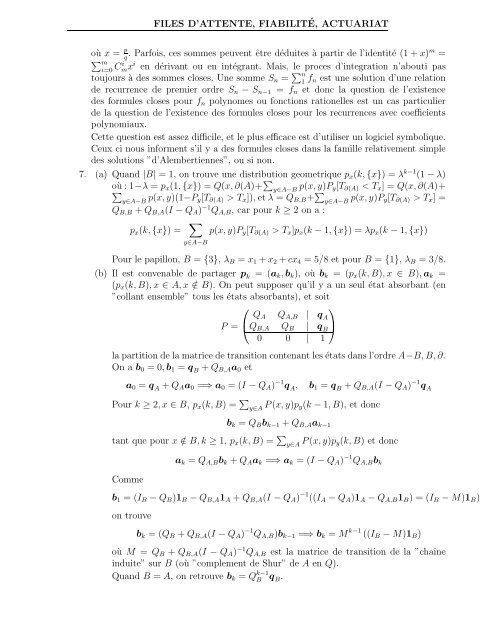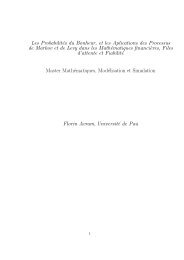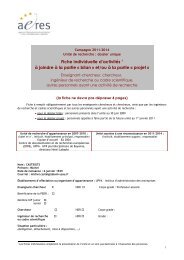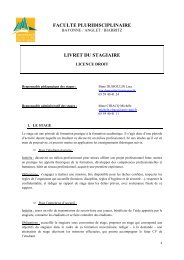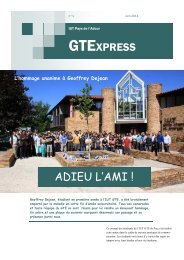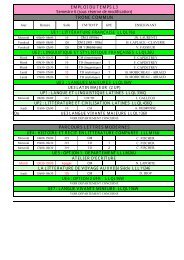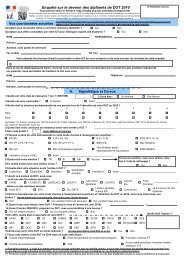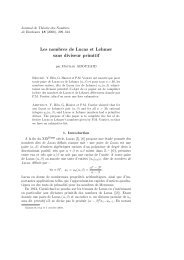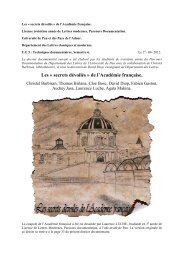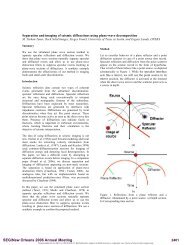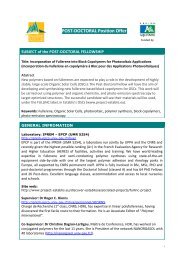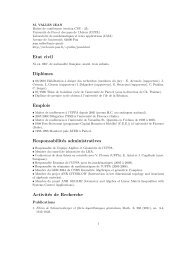Processus de Markov, de Levy, Files d'attente, Actuariat et Fiabilité ...
Processus de Markov, de Levy, Files d'attente, Actuariat et Fiabilité ...
Processus de Markov, de Levy, Files d'attente, Actuariat et Fiabilité ...
You also want an ePaper? Increase the reach of your titles
YUMPU automatically turns print PDFs into web optimized ePapers that Google loves.
FILES D’ATTENTE, FIABILITÉ, ACTUARIAT<br />
où x = p . Parfois, ces sommes peuvent être déduites à partir <strong>de</strong> l’i<strong>de</strong>ntité (1 + q x)m =<br />
∑ m<br />
i=0 Ci mx i en dérivant ou en intégrant. Mais, le proces d’integration n’abouti pas<br />
toujours à <strong>de</strong>s sommes closes. Une somme S n = ∑ n<br />
1 f n est une solution d’une relation<br />
<strong>de</strong> recurrence <strong>de</strong> premier ordre S n − S n−1 = f n <strong>et</strong> donc la question <strong>de</strong> l’existence<br />
<strong>de</strong>s formules closes pour f n polynomes ou fonctions rationelles est un cas particulier<br />
<strong>de</strong> la question <strong>de</strong> l’existence <strong>de</strong>s formules closes pour les recurrences avec coefficients<br />
polynomiaux.<br />
C<strong>et</strong>te question est assez difficile, <strong>et</strong> le plus efficace est d’utiliser un logiciel symbolique.<br />
Ceux ci nous informent s’il y a <strong>de</strong>s formules closes dans la famille relativement simple<br />
<strong>de</strong>s solutions ”d’Alembertiennes”, ou si non.<br />
7. (a) Quand |B| = 1, on trouve une distribution geom<strong>et</strong>rique p x (k, {x}) = λ k−1 (1 − λ)<br />
où : 1−λ = p x (1, {x}) = Q(x, ∂(A)+ ∑ ∑<br />
y∈A−B p(x, y)P y[T ∂(A) < T x ] = Q(x, ∂(A)+<br />
y∈A−B p(x, y)(1−P y[T ∂(A) > T x ]), <strong>et</strong> λ = Q B,B + ∑ y∈A−B p(x, y)P y[T ∂(A) > T x ] =<br />
Q B,B + Q B,A (I − Q A ) −1 Q A,B , car pour k ≥ 2 on a :<br />
p x (k, {x}) = ∑<br />
p(x, y)P y [T ∂(A) > T x ]p x (k − 1, {x}) = λp x (k − 1, {x})<br />
y∈A−B<br />
Pour le papillon, B = {3}, λ B = x 1 + x 2 + cx 4 = 5/8 <strong>et</strong> pour B = {1}, λ B = 3/8.<br />
(b) Il est convenable <strong>de</strong> partager p k = (a k , b k ), où b k = (p x (k, B), x ∈ B), a k =<br />
(p x (k, B), x ∈ A, x /∈ B). On peut supposer qu’il y a un seul état absorbant (en<br />
”collant ensemble” tous les états absorbants), <strong>et</strong> soit<br />
⎛<br />
⎞<br />
Q A Q A,B | q A<br />
P = ⎝Q B,A Q B | q B<br />
⎠<br />
0 0 | 1<br />
la partition <strong>de</strong> la matrice <strong>de</strong> transition contenant les états dans l’ordre A−B, B, ∂.<br />
On a b 0 = 0, b 1 = q B + Q B,A a 0 <strong>et</strong><br />
a 0 = q A + Q A a 0 =⇒ a 0 = (I − Q A ) −1 q A ,<br />
b 1 = q B + Q B,A (I − Q A ) −1 q A<br />
Pour k ≥ 2, x ∈ B, p x (k, B) = ∑ y∈A P(x, y)p y(k − 1, B), <strong>et</strong> donc<br />
b k = Q B b k−1 + Q B,A a k−1<br />
tant que pour x /∈ B, k ≥ 1, p x (k, B) = ∑ y∈A P(x, y)p y(k, B) <strong>et</strong> donc<br />
Comme<br />
a k = Q A,B b k + Q A a k =⇒ a k = (I − Q A ) −1 Q A,B b k<br />
b 1 = (I B − Q B )1 B − Q B,A 1 A + Q B,A (I − Q A ) −1 ((I A − Q A )1 A − Q A,B 1 B ) = (I B − M)1 B )<br />
on trouve<br />
b k = (Q B + Q B,A (I − Q A ) −1 Q A,B )b k−1 =⇒ b k = M k−1 ((I B − M)1 B )<br />
où M = Q B + Q B,A (I − Q A ) −1 Q A,B est la matrice <strong>de</strong> transition <strong>de</strong> la ”chaîne<br />
induite” sur B (où ”complement <strong>de</strong> Shur” <strong>de</strong> A en Q).<br />
Quand B = A, on r<strong>et</strong>rouve b k = Q k−1<br />
B q B.


